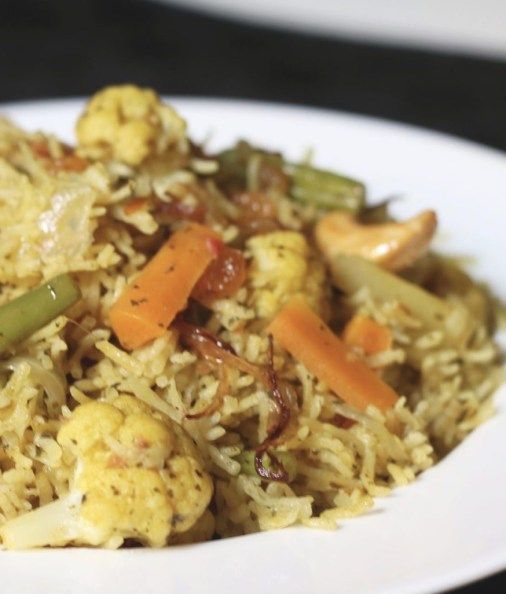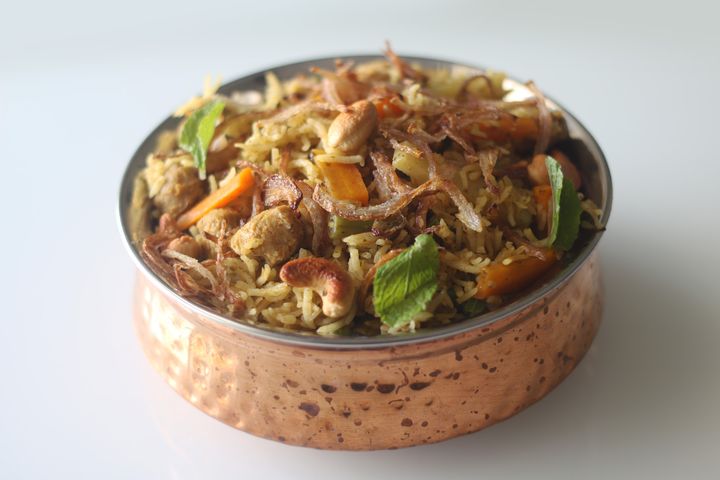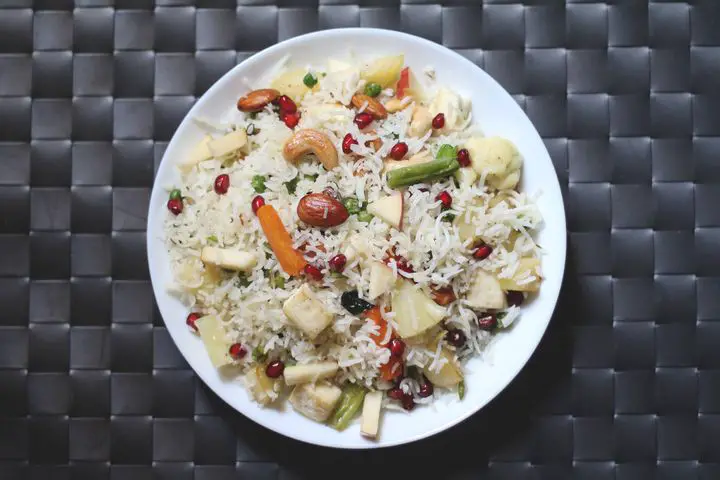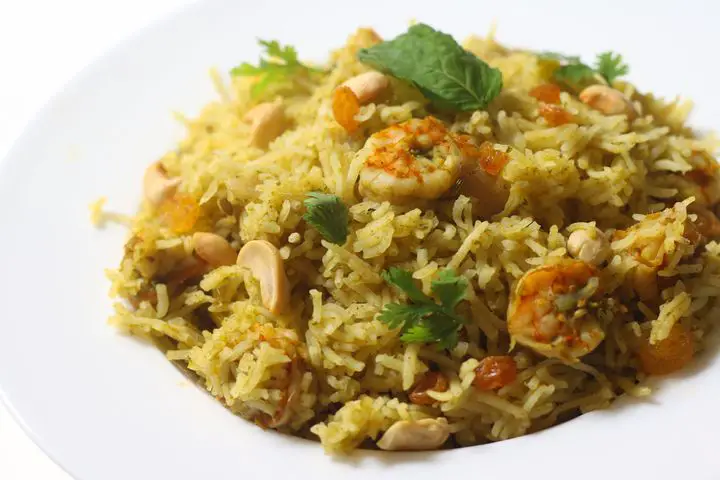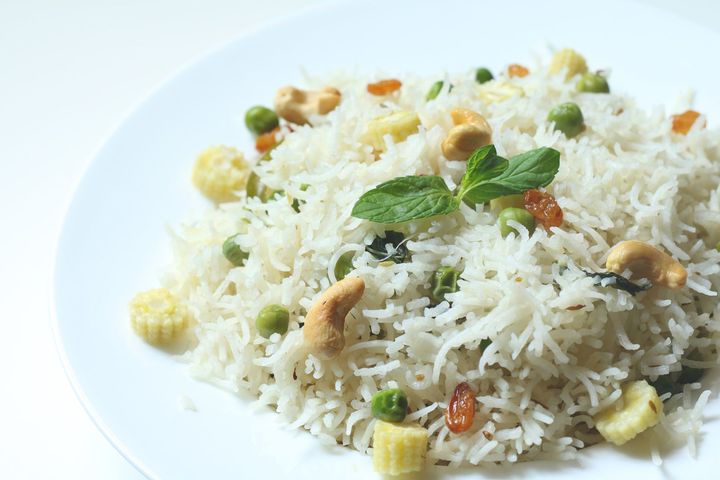South Indian Vegetable Biryani
Vegetable Biryani: The Flavorful and Colorful South Indian Dish Perfect for Vegetarian Parties!
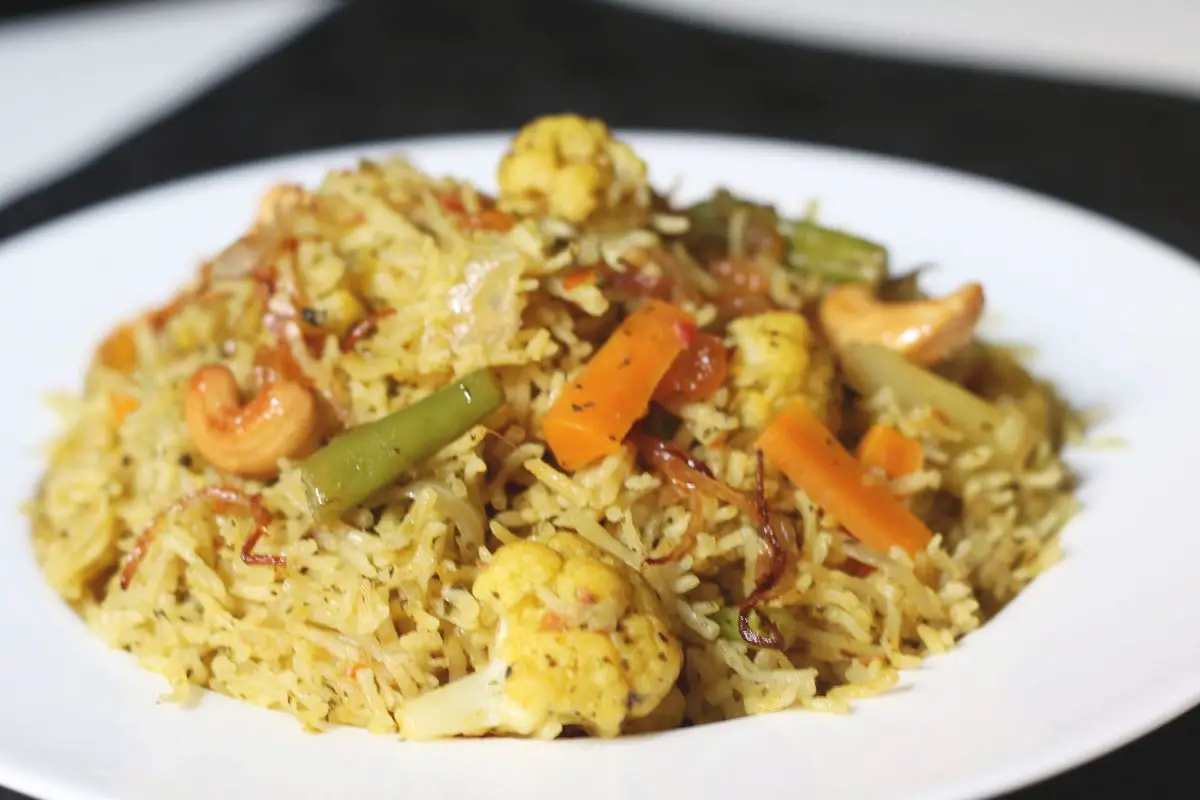
If you're a fan of flavorful and aromatic rice dishes, then South Indian vegetable biryani is a must-try for you. This vegetarian version of biryani is packed with a delicious medley of vegetables and aromatic spices, creating a dish that is both comforting and satisfying. In this blog post, we'll walk you through the steps to create this unique and flavorful recipe. So let's dive in and explore the world of South Indian vegetable biryani!
What Is South Indian Vegetable Biryani?
- South Indian vegetable biryani is a flavorful and aromatic dish that combines succulent vegetables with fragrant Indian spices and unique seasoning. This traditional dish is known for its delicious blend of basmati rice, coconut milk, and a variety of vegetables, creating a wholesome and satisfying meal.
- The combination of spices like garam masala, turmeric, and red chili powder, along with the tempering of fennel seeds, cloves, and cinnamon, adds depth and complexity to the dish, making it a popular choice for vegetarians and non-vegetarians alike.
- With its distinct flavors and vibrant colors, South Indian vegetable biryani is a must-try for anyone looking to experience the rich culinary heritage of Indian cuisine.
Why You'll Love South Indian Vegetable Biryani?
- Deliciously Textured: The South Indian vegetable biryani is packed with a variety of vegetables, creating a symphony of flavors and textures in every bite. The combination of soft and crunchy veggies alongside the fluffy basmati rice makes for a truly delightful eating experience.
- Healthy and Nutritious: This biryani is not only delicious but also loaded with nutritious vegetables, providing essential vitamins, minerals, and fiber. The use of coconut milk adds a creamy texture while also offering health benefits, making it a wholesome meal option.
- Vibrant and Colorful: The diverse mix of colorful veggies like carrots, green beans, and cauliflower not only enhances the visual appeal of the dish but also indicates the abundance of different nutrients present in the biryani, making it a feast for the eyes and the palate.
- Easily Customizable: This recipe can be easily customized by adding or substituting vegetables to suit your taste preferences or dietary requirements, making it a versatile dish for everyone to enjoy.
- Balanced Flavor Profile: With the perfect blend of spices, such as garam masala, turmeric, and chili powder, this biryani offers a well-balanced flavor profile, providing a delightful mix of aromatic and savory notes in every mouthful.
- Satisfying and Filling: The combination of rice and vegetables in this biryani makes it a filling and satisfying meal, perfect for lunch or dinner, and sure to leave you feeling nourished and content after enjoying it.
Ingredients for South Indian Vegetable Biryani
Basmati Rice:
Basmati rice is the key ingredient in any biryani recipe. It adds a fragrant, long-grained, and fluffy texture to the biryani.
Coconut Milk:
Coconut milk not only adds a subtle sweetness but also enhances the overall creamy texture and flavor of the biryani.
Carrot, Green Beans, Potato, Green Peas, Cauliflower:
These vegetables add a burst of color, flavor, and nutrition to the biryani. They also contribute to the overall texture and make the biryani more filling.
Onion and Tomato:
Onions add a sweet and savory flavor, while tomatoes add a tangy and juicy element to the biryani. Both these ingredients contribute to the rich and aromatic gravy of the biryani.
Ginger and Garlic Paste:
This paste adds a strong and distinct flavor to the biryani, and it also acts as the base for the spice mix, enhancing the overall taste.
Garam Masala and Turmeric Powder:
Garam masala brings warmth and an aromatic flavor, while turmeric powder adds a vibrant color and a slightly bitter taste to the biryani. Both spices are essential for authentic South Indian flavors.
How To Make South Indian Vegetable Biryani?
- To make a delicious South Indian vegetable biryani, start by cleaning and preparing all the vegetables. Then, blanch the cauliflower and set it aside. Next, blend the tomatoes into a smooth puree, and grind the green chilis, mint leaves, and coriander leaves coarsely.
- After that, wash and soak the rice in water and coconut milk, and heat a pan to fry the cashew nuts, raisins, and onions for garnishing. In the same pan, sauté the ingredients for tempering, and then add the remaining onions, ginger and garlic paste, and the ground mint, coriander, and chili mixture.
- Next, add the chopped vegetables, green peas, and tomato puree, and cook until the gravy becomes slightly thick. Then, add the spices and salt, and cook for another 5 minutes until the gravy separates from the oil.
- Meanwhile, cook the rice in an electric cooker, and when it starts to boil, add the prepared masala and the remaining salt. Cook until the electric cooker switches to 'Keep warm', and let it sit for another 10 minutes before serving.
The key steps to pay attention to are the preparation of the masala and the cooking of the vegetables, as these are crucial for achieving the authentic, flavorful experience of South Indian vegetable biryani.
Serving Suggestions
- Pair with Raita: Serve the South Indian vegetable biryani with a side of refreshing raita. The cool and creamy yogurt-based dish complements the spiciness of the biryani, making it a perfect combination.
- Accompany with Papad: Add some crunch to your meal by serving papad alongside the vegetable biryani. The crispy texture of papad pairs well with the flavorful and aromatic biryani.
- Serve with Pickle: Enhance the taste of the biryani with a side of tangy and spicy pickle. The combination of the pickle's bold flavors with the biryani's rich aromatic taste will surely tantalize your taste buds.
- Pair with Cucumber Salad: A light and refreshing cucumber salad makes a great accompaniment to the vegetable biryani. The fresh and crisp flavors of the salad are a perfect balance to the savory and satisfying biryani.
- Garnish with Fried Onions: Sprinkle some fried onions on top of the biryani to add an extra layer of flavor and texture. The crispy and caramelized onions will elevate the dish and provide a delightful crunch.
- Accompany with Mango Lassi: Cool down your palate with a sweet and creamy mango lassi. The refreshing drink makes a wonderful pairing with the spicy and aromatic vegetable biryani, creating a well-rounded and satisfying meal.
Tips for Making South Indian Vegetable Biryani
- Preparation Duration: The preparation for South Indian vegetable biryani may take some time, especially with chopping and grinding the ingredients. It is important to set aside enough time to ensure that the vegetables are properly cleaned and cut, and the necessary spices are ground and blended.
- Cooking Techniques: It is important to follow the cooking techniques carefully, such as blanching the cauliflower and grinding the mint, coriander, and chili mixture coarsely. Additionally, sauteing the onions, tomatoes, and spices until the raw smell goes away is crucial for the flavor of the biryani.
- Importance of Garnishing: Garnishing the vegetable biryani with cashew nuts, raisins, fried onions, and coriander leaves is not only for presentation but also adds texture and flavor to the dish. It is essential to take the time to garnish the biryani before serving to enhance its overall appeal.
Variations for South Indian Vegetable Biryani
- Vegetable Choices: Feel free to mix and match different vegetables in your biryani. You can add bell peppers, zucchini, or even mushrooms for a different flavor and texture.
- Spice Level: Adjust the amount of red chili powder and green chilies to suit your spice preference. For a milder version, reduce the amount of chili powder, or for a spicier kick, increase the quantity of green chilies.
- Protein Boost: Add protein to your biryani by including paneer, tofu, or even chickpeas. These additions will make the dish more filling and nutritious.
- Herb Infusion: Experiment with different herbs like curry leaves, lemongrass, or even basil to elevate the flavor profile of your biryani.
- Nutty Twist: Enhance the nuttiness of the dish by using almonds, pistachios, or even cashews with different combinations for a unique crunch.
- Aromatic Oils: Switch up the cooking oils to infuse different flavors. Try using coconut oil, sesame oil, or even mustard oil for a distinct taste in your vegetable biryani.
How to Store South Indian Vegetable Biryani
Storing Cooked Biryani:
- Let the vegetable biryani cool down before storing it.
- Transfer the biryani into an airtight container and refrigerate it. This will help in maintaining its freshness for a few days.
Storing Ingredients:
- Ensure that the vegetables are stored in the refrigerator to keep them fresh for use in the biryani.
- Keep the spices and herbs in airtight containers to retain their aroma and flavor.
Reheating the Biryani:
- When reheating the biryani, sprinkle a little water over it and gently mix to prevent it from drying out.
- Heat it in the microwave or on the stovetop until it is heated through.
By following these simple storage tricks, you can enjoy the delicious South Indian Vegetable Biryani even after it's been prepared.
Frequently Asked Questions (FAQs)
Can I use different vegetables in South Indian vegetable biryani?
- Yes, you can definitely customize the vegetables based on your preference. You can add bell peppers, baby corn, or any other vegetables of your choice to enhance the flavors.
How can I make the biryani less spicy?
- If you prefer a milder version of the biryani, you can reduce the amount of red chili powder and green chilies in the recipe. You can also increase the amount of coconut milk to balance out the spiciness.
Can I make South Indian vegetable biryani without coconut milk?
- Yes, if you do not have coconut milk or prefer not to use it, you can substitute it with an equal amount of water or vegetable broth. This will still result in a delicious biryani with a slightly different flavor profile.
Can I make this recipe ahead of time?
- Yes, you can prepare the masala and vegetable mixture in advance and store it in an airtight container in the refrigerator. When you're ready to serve, simply reheat the mixture and mix it with freshly cooked rice.
Can I make South Indian vegetable biryani in a pressure cooker?
- Yes, you can prepare this biryani in a pressure cooker for a quicker cooking time. Simply follow the same steps of layering the rice and vegetable masala in the pressure cooker and cook it as you would for regular rice.
How can I make the biryani more flavorful?
- To enhance the flavors of the biryani, you can add a pinch of saffron soaked in warm water to the rice for a rich aroma and color. You can also add a teaspoon of rose water or kewra water for an added layer of fragrance.
South Indian Vegetable Biryani 2017-06-12 05:20:16

Recipe Card
South Indian Vegetable Biryani
Serves 3
Prep Time: 00:10
Cook Time: 00:35
Total Time: 00:45
Ingredients
To Cook Rice
- 2 cups Basmati Rice
- 3 cups Water
- 1 cup Coconut Milk
Veggies:
- 1 medium sized Carrot
- 6 Green Beans
- 1 small sized Potato
- 1 handful Green Peas (frozen)
- 10 small sized Cauliflower Florets
- 1 large sized (100 gm) Onion
- 1 big sized (150 gm) Tomato
Other Ingredients:
- 2 tsp Ginger and Garlic Paste
- 1/2 tsp Red Chili Powder
- 1 tsp Garam Masala Powder
- 1/4 tsp Turmeric Powder
- 1 tsp (divided) Salt
- 1 tbsp (I used olive oil) and 1 tbsp ghee or 2 tbsp oil Oil
To Grind
- 2 Green Chillis
- 3 tbsp Mint Leaves
- 4 tbsp Coriander Leaves
To Temper
- 1/2 tsp Fennel Seeds
- 3 Cloves
- 1 Cardamon
- 2 - 1 inch Cinnamon Sticks
- 1/2 Bay Leaf
To Garnish
- 10 Cashew Nuts
- 15 Raisins
- 1 tbsp of finely chopped Coriander Leaves or Mint Leaves
Instructions
- Firstly, clean all the vegetables. Peel and then cut the carrot, beans and potato in 2 inches lengthwise.
- Then blanch the cauliflower and keep it aside.
- Then cut the onion lengthwise.
- Place the tomatoes in a blender, blend until a smooth puree.
- Then grind the ingredients given under "To Grind" coarsely without adding any water.
- Finally, wash and soak the rice in 2 cups of water and 1 cup of coconut milk in the electric cooker vessel itself and keep it aside.
- Meanwhile, heat a pan over medium heat, add oil and ghee.
- When the oil heats, fry cashew nuts till they turn golden brown, then add raisins and saute for 10 seconds until puffed. Remove them from the pan and keep it aside.
- In the same pan, also add one handful of onions and fry them till golden brown and keep it aside. These nuts, raisins and onions are used for garnishing.
- Heat the remaining oil and saute the ingredients given under ''To temper''until spluttering and add the remaining onion and fry till it turns golden brown.
- Also add ginger and garlic paste and saute well till the raw smell goes away.
- Then add mint, coriander and chili mixture and fry for one minute.
- Place all the chopped vegetables and green peas, saute well for one minute.
- Then add tomato puree and saute well till raw smell goes away(close the lid).
- When the tomato gravy becomes slightly thick, add red chili powder, turmeric powder, garam masala powder and 1/2 tsp of salt. Stir well.
- Turn the heat to low, and cook for another 5 minutes or until the gravy separates from the oil along the sides of the pan. Remove from the heat and keep it aside.
- Meanwhile, switch on the electric cooker and cook the rice side by side.
- When the rice starts to boil, add that masala and the remaining 1/2 tsp salt to the rice and mix well.
- Close the lid and cook till the electric cooker switches to 'Keep warm'. It takes a maximum of around 10 mins. Every 5 minutes open the lid and mix the rice gently.
- When it comes to the 'Keep Warm' switch off the electric cooker, leave it for another 10 minutes. Now the Vegetable Biryani is ready to serve. Finally, garnish the dish with reserved nuts, raisins, fried onions and coriander leaves.
Two Methods to Try
If you have an electric cooker, here's a simple method for cooking it:
Electric Cooker Method:
Place the ingredients for the Vegetable Biryani in the electric cooker.
Follow the manufacturer's instructions to cook the dish.
However, if you prefer to cook your Vegetable Biryani in a pan, here's another method to try:
Pan Method:
Soak the basmati rice in plenty of water for 20 minutes.
Drain the water after 20 minutes.
In the pan, add 2 cups of water and 1 cup of coconut milk.
Cook the Vegetable Biryani, following the recipe's instructions.
No matter which method you choose, the end result will be a delicious and flavorful Vegetable Biryani that will leave you and your guests satisfied. So why not try cooking it today?"
By Santhi Therese
The Indian Claypot
